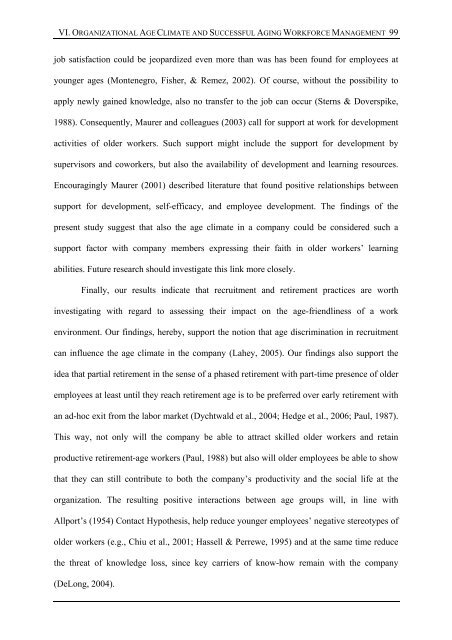Age Climate in Organizations - Jacobs University
Age Climate in Organizations - Jacobs University
Age Climate in Organizations - Jacobs University
Create successful ePaper yourself
Turn your PDF publications into a flip-book with our unique Google optimized e-Paper software.
VI. ORGANIZATIONAL AGE CLIMATE AND SUCCESSFUL AGING WORKFORCE MANAGEMENT 99<br />
job satisfaction could be jeopardized even more than was has been found for employees at<br />
younger ages (Montenegro, Fisher, & Remez, 2002). Of course, without the possibility to<br />
apply newly ga<strong>in</strong>ed knowledge, also no transfer to the job can occur (Sterns & Doverspike,<br />
1988). Consequently, Maurer and colleagues (2003) call for support at work for development<br />
activities of older workers. Such support might <strong>in</strong>clude the support for development by<br />
supervisors and coworkers, but also the availability of development and learn<strong>in</strong>g resources.<br />
Encourag<strong>in</strong>gly Maurer (2001) described literature that found positive relationships between<br />
support for development, self-efficacy, and employee development. The f<strong>in</strong>d<strong>in</strong>gs of the<br />
present study suggest that also the age climate <strong>in</strong> a company could be considered such a<br />
support factor with company members express<strong>in</strong>g their faith <strong>in</strong> older workers’ learn<strong>in</strong>g<br />
abilities. Future research should <strong>in</strong>vestigate this l<strong>in</strong>k more closely.<br />
F<strong>in</strong>ally, our results <strong>in</strong>dicate that recruitment and retirement practices are worth<br />
<strong>in</strong>vestigat<strong>in</strong>g with regard to assess<strong>in</strong>g their impact on the age-friendl<strong>in</strong>ess of a work<br />
environment. Our f<strong>in</strong>d<strong>in</strong>gs, hereby, support the notion that age discrim<strong>in</strong>ation <strong>in</strong> recruitment<br />
can <strong>in</strong>fluence the age climate <strong>in</strong> the company (Lahey, 2005). Our f<strong>in</strong>d<strong>in</strong>gs also support the<br />
idea that partial retirement <strong>in</strong> the sense of a phased retirement with part-time presence of older<br />
employees at least until they reach retirement age is to be preferred over early retirement with<br />
an ad-hoc exit from the labor market (Dychtwald et al., 2004; Hedge et al., 2006; Paul, 1987).<br />
This way, not only will the company be able to attract skilled older workers and reta<strong>in</strong><br />
productive retirement-age workers (Paul, 1988) but also will older employees be able to show<br />
that they can still contribute to both the company’s productivity and the social life at the<br />
organization. The result<strong>in</strong>g positive <strong>in</strong>teractions between age groups will, <strong>in</strong> l<strong>in</strong>e with<br />
Allport’s (1954) Contact Hypothesis, help reduce younger employees’ negative stereotypes of<br />
older workers (e.g., Chiu et al., 2001; Hassell & Perrewe, 1995) and at the same time reduce<br />
the threat of knowledge loss, s<strong>in</strong>ce key carriers of know-how rema<strong>in</strong> with the company<br />
(DeLong, 2004).
















